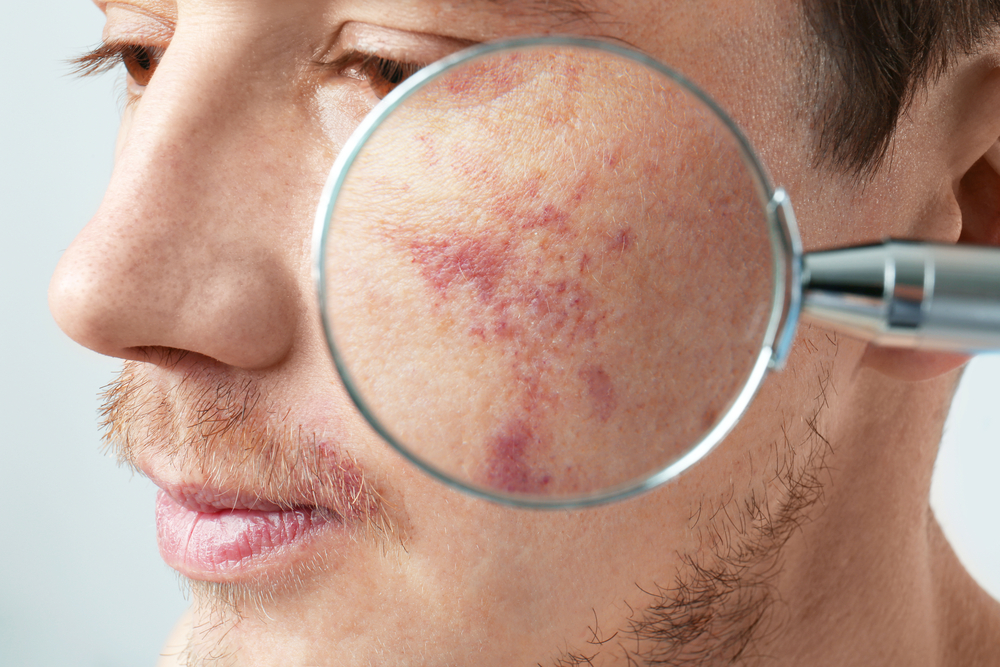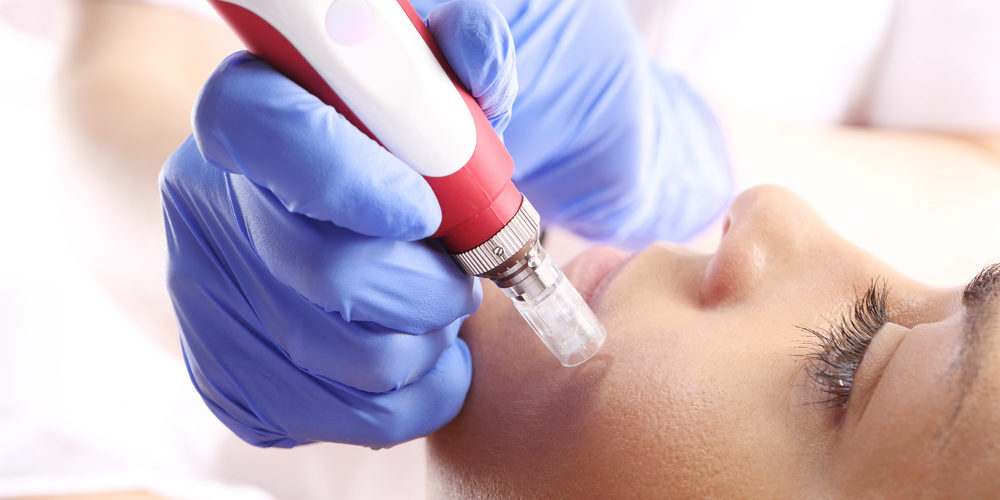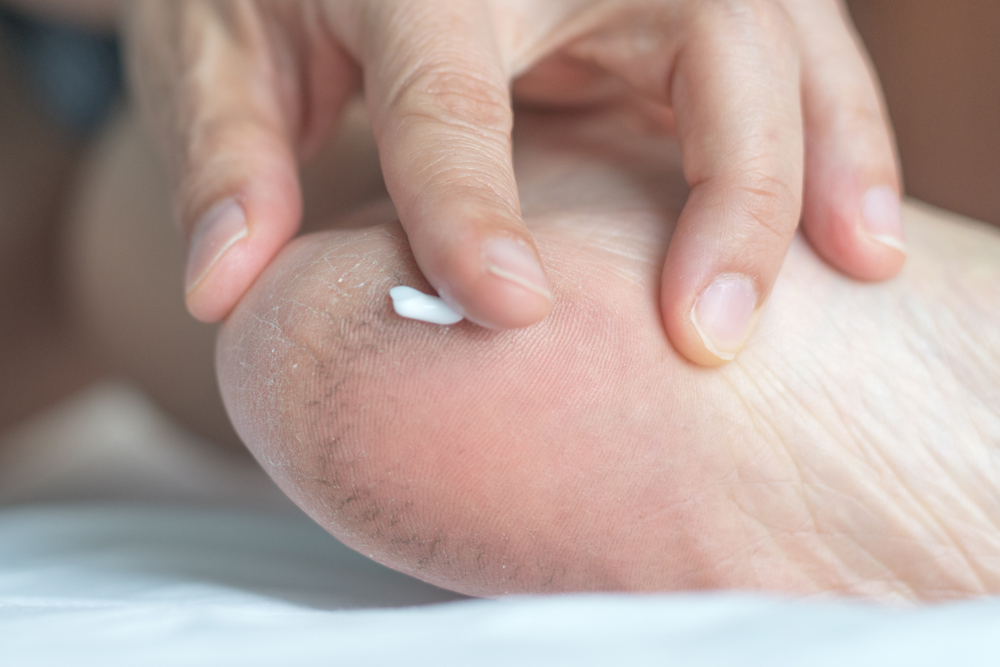The term “port-wine stain” may sound innocent or even poetic, but to those born with these red and purple birthmarks, they can be a lifelong source of anxiety. We spoke with New Jersey dermatologist Dr. Sandy Milgraum about how lasers treatments can significantly reduce the appearance of port-wine stains in children and adults.
What Are Port-Wine Stains?
Port-wine stains, or nevus flammeus as they are known medically, are caused by a blood vessel malformation. Capillaries in the affected areas become permanently dilated, leading to reddish or purple patches of discolored skin.
Approximately one in two hundred people are born with port-wine stains. And while we may call them “birthmarks,” they’re not always visible at the time of birth. In some cases they appear later in life as the result of physical trauma, or as a symptom of serious illnesses such as Sturge Weber syndrome or Klippel–Trénaunay–Weber syndrome.
In most instances however, a port-wine stain is a simple, genetically determined birthmark — one which can have deeply negative effects on confidence, quality-of-life and self-image.
Approximately 60% of all port-wine stains appear around the face and head, but they can occur on nearly any part of the body. In some cases they are located in the top layers of the skin, while others lie deep beneath the surface and take on a darker, bluish tone. These deep blue birthmarks are referred to as “cavernous,” and can be more difficult to treat than those found in the higher levels of the skin, which tend to be bright-red.
Can Port-Wine Stains Go Away on Their Own?
In children, port-wine stains often start as smooth, light-pink marks. Over time they typically darken, reaching a deep “wine color” later in adulthood. As time goes by, port-wine stains may also become raised, or develop small bumps as the lesions thicken.
“Port-wine stains are often confused with other types of birthmark that slowly disappear over time,” says Dr. Milgraum. “When untreated, port wine stains are permanent — they are present at birth, and only get darker and thicker over time.”
In some cases, port-wine stains can also lead to more serious health issues later on in life. As the birthmarks grow, they can cause spontaneous bleeding and inhibit motion. Glaucoma is another potential complication, occuring in 50% of cases associated with Sturge Weber syndrome between infancy and later childhood.
Because the appearance of port-wine stains tends to worsen, surgeons typically recommend that pulsed-dye laser treatments be performed early on in life. In children, the affected areas are generally smaller, paler, and smoother.
“Over time, port-wine stains become dark purple, with a thick, cobblestoned appearance and unsightly lumps… It’s a good idea to get them taken care of as soon as possible,” advises Milgraum.
Can Port-Wine Stains Be Removed?
Unfortunately, there’s no simple answer to this question — results vary, and the birthmark may not be entirely eliminated in all cases. Typically, the closer the birthmark is to the heart, the easier it is to remove. The skin’s tone, its texture, and the depth of the affected vessels are also determining factors.
With that said, laser procedures have been shown to be very effective, and remain the safest and most popular treatment option. By delivering focused heat to the lower layers of skin, these devices allow the surgeon to cut off the dilated capillaries’ blood flow.
In many cases the birthmark’s appearance can be reduced by 25% in just one to three visits, depending on its starting size, color, and depth. However, some patients will receive ten or more treatments in all, and even then it may still be somewhat visible.
Laser Treatments for Port-Wine Stains: What to Expect
A doctor can usually diagnose a port wine stain by looking at the skin. However, a biopsy and more extensive tests are sometimes needed, depending on the patient’s medical history and the size or location of the birthmark. If it’s near an eye or eyelid, the patient may also be referred to an ophtamologist to measure the fluid pressure inside the eye.
Children often undergo laser treatments starting at three to six months of age. In such cases an MRI may be ordered to rule out Sturge-Weber syndrome, which is often associated with port-wine stains — and is a much more serious health condition.
Most surgeons favor pulsed dye lasers for the treatment of port wine stains, but other lasers are also commonly used and can produce excellent results.
Depending on the type of laser and the birthmark’s location, patients are required to wear either specialized glasses or opaque laser-proof eye covers. Some lasers also come with a “dynamic cooling device” (DCD), which sprays a cooling topical cryogen onto the top layer of skin. This cooling agent helps to protect the skin, reducing pain and discomfort.
During the procedure, the plastic surgeon will move the laser device over the birthmark, firing short bursts at multiple predetermined points. While this may sound somewhat invasive, most of the work is done well beneath the skin’s surface, causing minimal damage to the visible, outer layers.
Topical or general anesthesia may be required, depending on the size and location of the birthmark. Dr. Milgraum advises against general anesthesia for children, however.
“They used to use general anesthesia on infants,” say Milgram. “We don’t do that anymore, as it’s been shown to affect IQ and may cause permanent brain damage. We are extremely leery of giving young children general anesthesia today. This is another reason to start treatments early, so the child doesn’t remember the procedure — though with local anesthesia they feel nothing.”
Each laser treatment is typically quite short. The entire session may be over in less than 10 minutes, depending on the specifics of the birthmark.
The time between treatments is generally between one and two months. As Dr. Milgraum points out, faster is often better: “We used to do them every two months. But it’s been shown that if you increase the frequency to once a month or more you can get a better response.”
Recovery and Side Effects
The recovery period usually lasts one or two weeks. Immediately following each session there is noticeable bruising of the soft tissue around the birthmark, along with general redness and swelling in the surrounding area.
Some crusting, peeling and blistering can also develop, particularly if overlapping pulses were used. These blisters can be covered in simple petroleum jelly and bandages to help them heal faster.
Laser therapy tends to be very safe. In rare instances they may cause scarring or hypopigmentation, but generally speaking the risks of complications are low, especially when the recommended safety precautions are adequately followed.
How Much Does Laser Birthmark Removal Cost?
The cost of birthmark removal treatments depends on several factors. Estimates vary widely — from a few hundred dollars to several thousands — depending on the number of sessions required, the patient’s age, the size of the birthmark, and its location. An individual consultation with a plastic surgeon is required for any realistic estimate.
Also keep in mind that laser treatments for port-wine stains are unlikely to result in a 100% removal. However, 90% reductions are common and very achievable.
It’s Not Too Late If You’re an Adult
While it’s easier and generally more effective to address port-wine birthmarks during infancy, adults can benefit from laser treatments as well.
In fact, Dr. Milgraum’s adult patients are often surprised and delighted to learn about their options.
“To tell you the truth, most of our patients are not young children, but adults who have never been treated before,” says Milgraum. “It’s amazing. After all these years, the birthmark darkens and they discover that something can be done about this thing they’ve had all their life — and they finally do it.”









